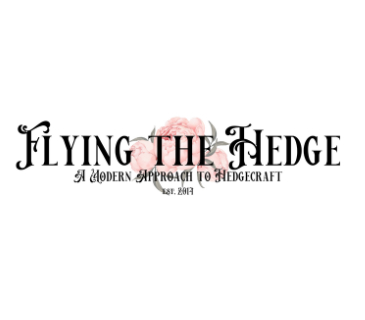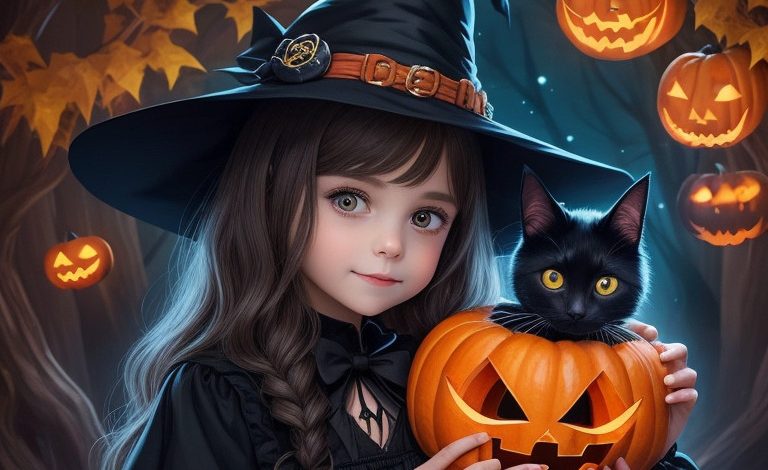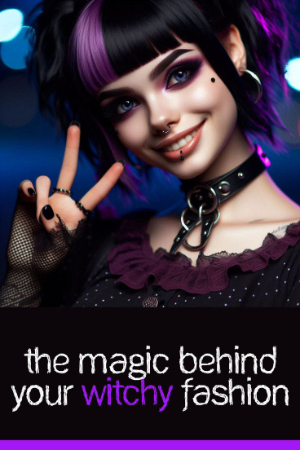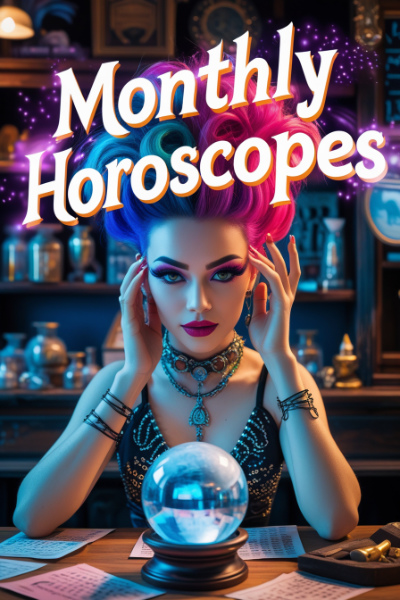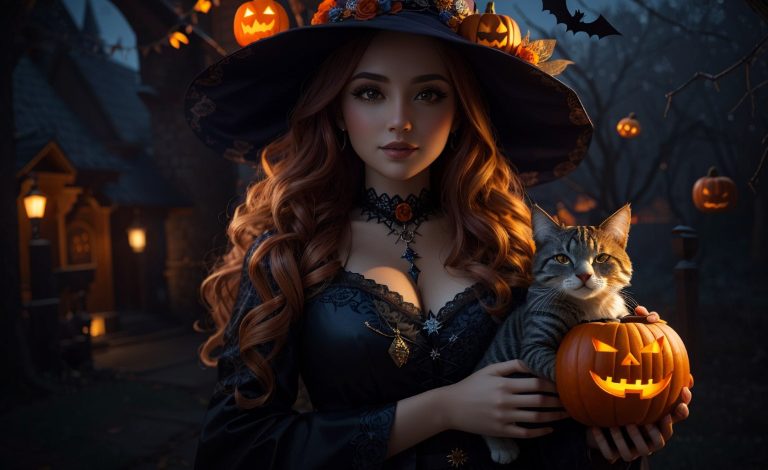
Halloween, the spooky holiday celebrated on October 31st, is steeped in centuries-old traditions and superstitions. It’s a time when people embrace their inner ghouls and goblins, don creative costumes, and indulge in thrilling tales of the supernatural. In this detailed exploration, we will unravel the captivating world of Halloween superstitions and myths, diving deep into the folklore surrounding full moons, black cats, fortune-telling, and other enigmatic elements that make this holiday so intriguing.
The Mysterious Full Moon
One of the most enduring Halloween superstitions revolves around the full moon. It’s believed that during this lunar phase, the veil between the living and the spirit world is at its thinnest, allowing supernatural beings to roam freely. This notion has its roots in ancient Celtic and Druidic traditions, where the moon was revered as a powerful symbol.
People often associate the full moon with werewolves, vampires, and witches taking flight on their broomsticks. The eerie glow of a full moon adds to the spine-tingling ambiance of Halloween night. While science has debunked many myths about the moon’s influence on human behavior, the fascination with its mystical allure persists.
The Enigmatic Black Cat
Few symbols are as synonymous with Halloween as the black cat. Throughout history, these graceful felines have been both revered and reviled. In medieval Europe, black cats were thought to be witches’ familiars and were often associated with dark magic and bad luck. The superstition even led to the mass killing of black cats during the witch hunts.
On Halloween night, black cats are believed to possess special powers, such as the ability to see spirits and ward off evil. Crossing paths with one is considered an omen—either a sign of impending misfortune or good luck, depending on the culture. Despite the superstitions, black cats remain enchanting and mysterious creatures, adding a touch of mystique to the holiday.
Fortune Telling: The Art of Divination
Fortune telling is an integral part of Halloween tradition, and various methods have been used to predict the future on this eerie night. One popular practice is divination using apple peels or nuts. By peeling an apple in one long strip and throwing it over the shoulder, the shape it takes when it lands is said to reveal the initial of your future spouse’s name.
Another intriguing practice is scrying, where individuals gaze into reflective surfaces like mirrors or crystal balls to seek visions of the future. Tarot cards and Ouija boards also make appearances at Halloween gatherings, as participants attempt to communicate with spirits from the other side.
Ghosts, Goblins, and Haunted Tales
No Halloween would be complete without spooky ghost stories and tales of the supernatural. Whether it’s the legend of the Headless Horseman from Washington Irving’s “The Legend of Sleepy Hollow” or classic tales of haunted houses, these stories have become a staple of the holiday.
Many believe that Halloween night is when spirits return to the earthly realm to seek closure or play tricks on the living. This belief has given rise to traditions like leaving out offerings for spirits or carving jack-o’-lanterns to ward off evil entities.
The Legend of the Jack-O’-Lantern:
The tradition of carving pumpkins into spooky faces and placing candles inside them has its origins in an Irish legend about a man named Stingy Jack. According to the story, Jack tricked the devil and was denied entry to both heaven and hell upon his death. He was condemned to wander the earth with only a hollowed-out turnip lit with a coal to light his way. The Irish eventually adopted the pumpkin for their lanterns, creating the iconic jack-o’-lantern.
Witches’ Familiars:
Alongside black cats, witches were believed to have various animal companions like owls, toads, and ravens. These creatures were thought to assist witches in their magical endeavors. Seeing an owl or hearing its hoot on Halloween night was considered an omen, foretelling either good or bad luck.
The Curse of the Broken Mirror:
Breaking a mirror is said to bring seven years of bad luck, but on Halloween, the superstition takes a darker twist. It is believed that a broken mirror on this night can also open a portal to the spirit world, allowing malevolent entities to enter our realm. Some people avoid mirrors altogether on Halloween to prevent mishaps.
The Haunting Call of the Banshee:
In Irish folklore, the banshee is a ghostly woman whose mournful wails signal impending death in a family. It is said that on Halloween night, the banshee’s cries are especially chilling, serving as a grim reminder of the holiday’s connection to the supernatural and the afterlife.
The Curse of the Unburied Dead:
Traditionally, Halloween marked the end of the harvest season and the beginning of winter. It was also a time to honor the deceased. In some cultures, it was believed that failing to properly bury the dead or neglecting to leave offerings for them on Halloween night could result in curses or vengeful spirits haunting the living.
The Legend of the Halloween Witch’s Broomstick Flight:
According to folklore, on Halloween night, witches would gather and fly on broomsticks to attend their sinister gatherings known as “sabbats.” The idea of witches on broomsticks dates back to medieval Europe, where it was believed that witches could transform ordinary objects into magical flying tools. On Halloween, it was thought that witches took to the skies, soaring over villages and fields to cast spells and brew potions. The image of a witch flying across the full moon on her broomstick has become an iconic symbol of Halloween, adding to the air of mystery and enchantment that surrounds the holiday.
The Curse of the Unseen Faces:
Halloween masks are a staple of the holiday, but some superstitions caution against wearing masks that completely obscure the face. It is believed that concealing one’s identity in such a manner could attract the attention of malevolent spirits, who may mistake the masked person for one of their own. In some cultures, it’s thought that wearing a mask that hides your identity on Halloween could lead to a year of bad luck or even possession by a mischievous spirit. As a result, many revelers choose masks that reveal at least part of their faces, allowing them to enjoy the festivities without invoking the ire of the supernatural.
The Curse of the Empty Chair:
An empty chair at a Halloween gathering is said to invite unwanted spirits to join the festivities. It’s believed that ghosts and otherworldly beings can take a vacant seat and cause havoc during the celebration. To avoid this, some Halloween hosts set a place at the table for unseen guests or use the “empty chair” as an opportunity to honor deceased loved ones, leaving offerings or mementos to invite their presence in a positive way.
The Ghostly Hitchhiker:
This eerie superstition suggests that on Halloween night, if you encounter a lone traveler on the road, particularly one who appears lost or distressed, it may actually be a ghostly apparition. In some versions of the legend, picking up this ghostly hitchhiker and offering them assistance can lead to unsettling encounters, with the phantom passenger vanishing mysteriously or revealing their spectral nature.
The Echoing Footsteps of Death:
Another chilling Halloween belief is that if you hear footsteps or knocking at your door on Halloween night and find no one there when you investigate, it may be an omen of impending death. In some cultures, these unexplained sounds are attributed to restless spirits or death omens sent by the supernatural realm. Such encounters on Halloween night are taken very seriously, and people often exercise caution to avoid any encounters with the spectral world.
The Legend of the Headless Horseman:
Washington Irving’s classic tale, “The Legend of Sleepy Hollow,” has contributed significantly to Halloween lore. The story tells of the ghostly Headless Horseman, a Hessian soldier who lost his head during the American Revolutionary War and now haunts the town of Sleepy Hollow. Legend has it that the Headless Horseman rides forth on Halloween night in search of a new head. This myth has been passed down through generations, adding to the eerie atmosphere of Halloween with its portrayal of spectral riders and haunted woods.
The Curse of the Full Moon Transformation:
Building on the full moon’s connection to Halloween, the myth of lycanthropy, or werewolves, comes to life. According to this superstition, certain individuals possessed the ability to transform into wolves during a full moon, becoming uncontrollable beasts. The origins of this belief trace back to ancient times when people sought to explain strange behaviors or attacks under the light of a full moon. This myth has been popularized in countless books, movies, and folklore, contributing to the enduring fascination with creatures of the night during Halloween.
The Curse of the Halloween Prankster Spirits:
Halloween is known for its playful tricks and pranks, but some believe that these antics are not just the work of mischievous children. According to this superstition, the veil between the living and the spirit world is so thin on Halloween night that mischievous spirits and faeries are free to roam and join in the festivities. They may play tricks on unsuspecting individuals or engage in harmless pranks to test their mettle. While these encounters are generally benign, it’s a reminder that Halloween is a time when the supernatural world mingles with our own.
The Cursed Cauldron and Witches’ Brew:
Witches and their bubbling cauldrons are iconic symbols of Halloween. It is believed that on Halloween night, witches gather to brew potent potions and cast spells. The cauldron, often depicted as a source of magic and transformation, plays a central role in these legends. It is said that anyone who gazes into a witch’s cauldron on Halloween may catch a glimpse of their future, but this knowledge comes at a price. The curse of knowing one’s fate can be both a blessing and a burden, and it is a theme that adds depth to the mystique of Halloween.
The Ghostly Wedding:
In some cultures, it’s believed that Halloween is the one night when ghosts, particularly those of star-crossed lovers, can find each other and celebrate their long-awaited weddings. These spectral unions are said to take place in eerie, moonlit graveyards or at the crossroads of haunted forests. Witnessing a ghostly wedding on Halloween night is considered a rare and powerful omen, often tied to the themes of eternal love and the afterlife.
The Curse of the Wailing Woman:
This legend tells the story of “La Llorona,” a mournful and vengeful ghost who is said to roam rivers and waterways on Halloween night and beyond. In Mexican folklore, La Llorona was a woman who drowned her children in a fit of madness and grief, and she is forever cursed to search for them along the water’s edge. The wailing cries of La Llorona are believed to be a harbinger of tragedy, and encountering her on Halloween night is said to bring misfortune or even death. Parents often tell the tale of La Llorona to caution their children against venturing near water after dark.
The Bewitched Broomstick Dance:
In some cultures, it was believed that on Halloween night, witches would gather in secret locations to perform a bewitched broomstick dance. During this dance, they would summon the winds and spirits to aid them in their magical rituals. The broomstick, a symbol of the witch’s power, was central to these ceremonies, and it was thought to carry them through the night sky. Although witches and their broomstick flights are often depicted humorously in modern times, the ancient superstition surrounding their gatherings adds a layer of mystique to Halloween.
The Curse of the Halloween Hag:
This superstition warns of the Halloween hag, a malevolent witch-like figure who is said to visit homes on Halloween night to steal away misbehaving children. Parents would invoke the Halloween hag’s name to frighten their little ones into good behavior, and tales of her wicked deeds have persisted for generations. The idea of a sinister figure lurking in the shadows, ready to mete out punishment to unruly children, adds a chilling dimension to Halloween night.
The Cursed Blackthorn Tree:
In Celtic folklore, the blackthorn tree is associated with Halloween and the supernatural. It was believed that spirits and fairies dwelled within its branches. Cutting down or harming a blackthorn tree on Halloween night was thought to bring a curse upon the perpetrator. The tree’s sharp thorns and eerie appearance added to its mystique, making it a symbol of protection against malevolent forces. Even today, many people avoid interfering with blackthorn trees during the Halloween season to avoid bad luck.
The Alluring Power of the Vampire’s Gaze:
Vampires, immortal bloodsucking creatures, have long captured the imagination. According to legend, a vampire’s gaze has the power to mesmerize and control its victims. On Halloween night, when the boundary between the living and the undead is believed to be thin, encountering a vampire’s gaze could lead to enthrallment or even vampiric transformation. The fear of being drawn into the world of the undead adds an element of danger and seduction to Halloween’s supernatural tapestry.
The Haunting of the Ghostly Bride:
The legend of the ghostly bride is a haunting tale associated with Halloween. It tells of a young bride who tragically died on her wedding day, and her restless spirit roams the earth seeking a groom. On Halloween night, the ghostly bride is believed to appear to unsuspecting travelers, luring them with her ethereal beauty and wedding gown. Those who are enticed by her are said to vanish into the spirit world, forever joining her ghostly wedding procession. This eerie myth adds a sense of foreboding and melancholy to the Halloween atmosphere, reminding us that love and loss are timeless themes in the world of the supernatural.
The Curse of the Witching Hour:
The witching hour, typically thought to be midnight, holds a special significance on Halloween night. It is believed that during this hour, the powers of witches and other supernatural entities are at their peak. Any magical spells, curses, or rituals performed at the witching hour on Halloween are said to be exceptionally potent. People often stay indoors and take precautions during this time to avoid any malevolent spirits or witches who might be casting spells. The concept of the witching hour adds an element of suspense and anticipation to the Halloween experience.
The Bewitched Cauldron and the Potion of Transformation:
Cauldrons have been associated with witches and their brews for centuries. On Halloween night, it’s believed that witches gather to concoct a special potion known as the “Witch’s Brew.” This potion has the power to transform those who partake in it, either temporarily or permanently, into animals, other people, or supernatural beings. The idea of sipping from a cauldron and undergoing a magical metamorphosis adds an enchanting and mysterious element to Halloween folklore.
The Wandering Spirits of Forgotten Ancestors:
Halloween is often seen as a time when the spirits of the deceased return to visit the living. In some cultures, it is believed that these spirits may be ancestors who have been forgotten or neglected. To honor these wandering souls, people set out food offerings or light candles in their memory. Failure to acknowledge and respect these ancestral spirits can result in misfortune or curses. This tradition highlights the significance of remembering and connecting with one’s roots and departed loved ones during the Halloween season.
The Enchanted Mirror and the Gateway to the Otherworld:
Mirrors have long been considered portals to the spirit world, especially on Halloween night. According to superstition, if you gaze into a mirror on this eerie evening, you might catch a glimpse of the supernatural or even see your future. However, looking too deeply into the mirror can also draw spirits from the other side into our world. This duality of the mirror, as a source of both insight and danger, adds a layer of intrigue and caution to Halloween divination rituals.
The Phantom Ship of the Fog:
Halloween superstitions aren’t limited to land; they extend to the high seas as well. Legend has it that on Halloween night, a spectral ship known as the “Phantom Ship” emerges from the misty waters. This ghostly vessel is crewed by the restless spirits of sailors who met a tragic end at sea. Seeing the Phantom Ship on Halloween night is said to foretell impending maritime disasters. The eerie sight of a phantom ship silently gliding through the fog has fueled maritime superstitions for centuries, adding a nautical dimension to the mysteries of Halloween.
The Haunted Harvest:
In agricultural communities, Halloween marks the end of the harvest season and is deeply intertwined with ancient beliefs. Some believe that the last crops to be harvested on Halloween night are imbued with magical properties and can bring good fortune or protection when kept throughout the year. Conversely, neglecting to bring in the final harvest on Halloween night could result in a curse, causing a poor yield or crop failure in the following year. This superstition reflects the historical significance of Halloween as a time to celebrate the harvest and prepare for the winter months.
The Enchanted Forest and the Fairy Ring:
Folklore often associates Halloween with encounters with fairies and other supernatural beings. In particular, the “fairy ring” is a mysterious phenomenon where a circle of mushrooms or flowers appears overnight in the forest. Stepping inside a fairy ring on Halloween night is said to transport you into the fairy realm, where time passes differently, and you may emerge either blessed with good fortune or cursed with bad luck. The allure of hidden enchantment in the depths of the forest adds an element of magical wonder to Halloween.
The Bewitched Hand Mirror:
On Halloween night, some believe that a hand mirror left facing upward under the light of the moon can capture glimpses of future events or reveal hidden secrets. Those who dare to peer into the mirror may see visions, symbols, or even faces that foretell their destiny. However, using the mirror too often or for malevolent purposes is thought to invite dark forces or curses. This superstition underscores the theme of divination and mysticism associated with Halloween.
The Curse of the Phantom Horseman:
Similar to the Headless Horseman legend, the Phantom Horseman is a spectral figure who rides on Halloween night. This mysterious rider is often depicted as a dark, shadowy figure atop a ghostly steed. Encountering the Phantom Horseman on Halloween night is believed to be a portent of doom, foretelling misfortune or impending tragedy. The legend of the Phantom Horseman adds an element of suspense and trepidation to Halloween’s spectral tales, reminding us that the night is ripe with mysterious encounters.
The Beware of the Witch’s Knot:
Witches were believed to possess potent knowledge of knots and their magical properties. On Halloween night, a superstition warns against encountering a “witch’s knot,” a mysterious and intricate knot left in your path. It is said that if you step on or disturb this knot, you may fall under the spell or curse of the witch who left it there. This myth adds an element of suspense and caution to Halloween night, as people carefully inspect their surroundings for any signs of these enigmatic knots.
The Curse of the Phantom Hound:
In some cultures, Halloween is associated with the legend of the “Phantom Hound.” This spectral dog is believed to roam graveyards and ancient burial sites, guarding them from trespassers. Encountering the Phantom Hound on Halloween night is said to bring dire consequences, such as bad luck or even a haunting by restless spirits. This superstition underscores the belief that cemeteries are especially charged with supernatural energy on Halloween and should be treated with respect and reverence.
The Mischievous Pooka:
The Pooka is a mischievous creature from Irish folklore that is known for its shape-shifting abilities. On Halloween night, it is believed that the Pooka takes on various disguises to play tricks on unsuspecting humans. These tricks can range from minor pranks to more elaborate deceptions. It is said that offering the Pooka a saucer of milk or a small gift may appease its playful nature and prevent it from causing havoc. The Pooka adds a sense of whimsy and unpredictability to Halloween celebrations.
The Cursed Thirteenth Guest:
Halloween parties and gatherings have their own superstitions, one of which revolves around the number 13. It is said that if there are 12 guests at a Halloween gathering and a 13th uninvited guest arrives, it could be an omen of bad luck or misfortune. This belief echoes the superstition surrounding the number 13, which is often considered unlucky in various cultures. Hosts may take precautions to ensure their guest list remains at 12 to avoid this perceived curse.
The Enigmatic Key and the Portal to the Spirit World:
On Halloween night, it is said that an antique key left outside under the moonlight can become a conduit to the spirit world. This superstition suggests that the key might open a mystical door to realms beyond our own. Those who discover such a key are warned to use it with caution, as it can invite the presence of spirits, ghosts, or other supernatural entities. The concept of an ordinary object transforming into a mystical portal adds an element of intrigue and wonder to Halloween divination practices.
The Legend of the Halloween Owl:
Owls are often associated with Halloween, and their hooting calls on this night are thought to be a form of communication between the living and the spirit world. In some cultures, it’s believed that if an owl hoots while you’re outside on Halloween night, it’s an omen that foretells a forthcoming death or other misfortune. Conversely, seeing an owl during the daytime on Halloween is considered a good omen, symbolizing protection and wisdom. The mystical connection between owls and the supernatural adds an element of mystery to the holiday’s wildlife encounters.
The Curse of the Hollow Tree:
In some regions, there is a superstition about hollow trees on Halloween night. It is believed that these gnarled and empty trunks serve as portals for spirits to enter our world. Crossing paths with a hollow tree can invite these wandering spirits into your life, potentially leading to ghostly encounters or other supernatural experiences. The idea of seemingly innocuous trees harboring spectral secrets contributes to the eerie ambiance of Halloween.
The Moonlit Ritual of the Witch’s Sabbat:
The witch’s sabbat is a legendary gathering of witches and other supernatural beings held on Halloween night. During this gathering, they are said to engage in dark rituals, cast spells, and commune with otherworldly forces. The witches’ sabbat is believed to take place in remote, secluded locations, often under the light of the full moon. This myth adds a sense of foreboding and intrigue, suggesting that on Halloween night, the boundaries between the mundane and the magical become blurred.
The Mystic Powers of the Witch’s Broomstick:
The witch’s broomstick is not just a mode of transportation but also a symbol of magical power. According to some Halloween superstitions, on this night, witches leave their broomsticks outside under the moon to recharge their supernatural energies. Touching or tampering with a witch’s broomstick is thought to invite the wrath of the witch. This superstition emphasizes the deep connection between witches and their broomsticks, which play a central role in the imagery of Halloween.
The Tale of the Phantom Lanterns:
In some cultures, there’s a belief that on Halloween night, spectral lanterns or ghostly lights known as “will-o’-the-wisps” appear in swamps, marshes, and other desolate areas. These mysterious lights are said to lead travelers astray, causing them to become lost in the wilderness. The legend of the phantom lanterns adds an element of danger to Halloween night, cautioning against wandering too far from the safety of well-lit areas.
The Curse of the Wandering Souls:
On Halloween night, it’s believed that the spirits of the deceased are granted temporary release from the afterlife, allowing them to wander the Earth. While most of these spirits are harmless, some may seek vengeance or play tricks on the living. To protect themselves, people would carve faces into pumpkins and place candles inside, creating jack-o’-lanterns. These spooky lanterns were thought to ward off malevolent spirits and guide the lost souls back to the afterlife. The tradition of jack-o’-lanterns is a symbolic representation of the eternal struggle between the living and the dead during Halloween.
The Bewitched Mirror and the Reflection of Death:
Mirrors have long been associated with the supernatural, and on Halloween night, they take on an eerie significance. It is believed that staring into a mirror at midnight on Halloween can reveal your future or even show you glimpses of the afterlife. However, the reflection in the mirror may not always be your own; some claim to have seen the face of a loved one who has passed away or a spectral figure in the mirror’s depths. This superstition adds an element of mystery to the concept of self-reflection on Halloween, turning a seemingly ordinary act into a potentially supernatural experience.
The Enchanted Candles of Divination:
Candles play a crucial role in Halloween divination rituals. People would light candles and place them in front of mirrors, allowing the candlelight to cast eerie shadows. The shapes and movements of these shadows were interpreted as omens or messages from the spirit world. Some believed that if a candle flame flickered or went out on its own, it was a sign of a ghost’s presence. This practice added a sense of mystique to Halloween divination, inviting individuals to seek answers from the supernatural realm.
The Allure of the Phantom Masquerade:
Masquerade balls have been a Halloween tradition for centuries, and they are often associated with the idea of hiding one’s true identity and embracing the supernatural. The masks worn during these gatherings were believed to offer protection from malevolent spirits or to allow participants to take on a different persona for the night. Some even believed that wearing masks and costumes allowed them to communicate with spirits more freely. The masquerade tradition adds an element of enchantment and transformation to Halloween festivities.
The Curse of the Mysterious Riddles:
Halloween is a time when riddles and puzzles take on a mystical quality. It’s believed that solving a particularly challenging riddle on Halloween night can grant you access to hidden knowledge or even reveal the secrets of the spirit world. Riddles and enigmas are used in divination games and fortune-telling rituals, creating an air of anticipation and intrigue as participants seek to unlock the mysteries of the night.
The Curse of the Unlucky 13:
The number 13 has long been associated with superstitions and bad luck, and Halloween is no exception. Some believe that if you light 13 candles on Halloween night, it can invite misfortune or even the presence of malevolent spirits. Others avoid hosting gatherings with exactly 13 guests for fear that it may lead to bad luck. This superstition underscores the long-standing cultural apprehension surrounding the number 13 and adds an element of caution to Halloween celebrations.
The Enchanted Black Mirror:
Mirrors continue to hold a mystical allure on Halloween night. It is said that gazing into a black mirror, sometimes called a “scrying mirror,” can reveal glimpses of the future, insights into one’s fate, or even the presence of spirits. Those who practice scrying believe that the reflective surface can act as a portal to the spirit world. The idea of communicating with the unknown through a mirror’s reflection adds an element of mysticism to Halloween divination rituals.
The Veil Between Worlds:
Halloween is often seen as a time when the veil between the living and the dead is at its thinnest. This belief is rooted in ancient Celtic traditions, where it was believed that on Samhain (the precursor to Halloween), the spirits of the deceased returned to visit their earthly homes. To welcome these spirits, people would set out offerings of food and drink. It was also thought that costumes and masks were worn to confuse and ward off any malevolent spirits that might cross over. Today, many still embrace the idea of a thinner veil, making Halloween a night when we honor and remember our departed loved ones.
Final Musings;
Halloween’s rich tapestry of superstitions and myths adds layers of intrigue and mystique to the holiday. From the full moon’s eerie glow to the enigmatic black cat’s role in superstitions, the art of fortune telling, and the spine-tingling tales of the supernatural, Halloween invites us to embrace the unknown and revel in the mysterious. So, as you prepare to celebrate this captivating holiday, remember to keep an open mind and let the magic of Halloween fill your night with wonder and excitement. Happy Halloween!

